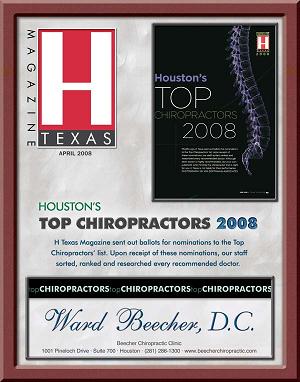School Back Packs and Back Pain
Clear Lake Chiropractor Comments: Every year millions of children walk around with heavy school back packs filled with books and supplies. While this is a good way to carry their school materials, by using their back and shoulder muscles, the tendency is to place too much strain on their neck and back due to overloading the back pack. The back will compensate for any load applied to it for an extended period of time. A heavy weight carried in backpacks can:
- Distort the natural curves in the middle and lower backs, causing muscle strain and irritation to the spine joints and the rib cage
- Lead to rounding of the shoulders
- Cause a person to lean forward, reducing balance and making it easier to fall
This problem can be made worse by carrying the pack on just one shoulder. Doing this causes the body to adapt by causing the body to lean to the other side placing additional stress on the mid and lower back as well as their associated muscles. This can lead to the children having headaches, shoulder, neck and back pain as well as pain down the arms and legs.
There is not a consensus among doctors on the correct amount of weight that a child can carry or the perfect back pack design, but parents should use common sense in choosing the best back pack for your child.
Look for backpack design features that help reduce the chance of back pain:
- Lightweight material (canvas as opposed to leather)
- Two padded, wide (2-inches), adjustable shoulder straps on the backpack
- Padded back
- Individualized compartments
- Hip strap, waist belt, or frame to redistribute the weight of the backpack from the shoulders and back to the pelvis
- Wheels so that the backpack can be pulled rather than carried
- Consider using a separate bag for the child’s laptop or other heavier electronic items
Dr. Ward Beecher practices at Beecher Chiropractic Clinic at 1001 Pineloch, Ste 700 Houston, TX 77062. You can schedule an appointment at BeecherChiropractic.com or by calling (281) 286-1300. If you have any questions regarding this blog, please comment below!

What Can I Do To Lower My Risk For Low Back Pain?
Houston Chiropractor Comments: Low back pain (LBP) can have many causes such as genetics, acquired abuses, body type (especially obesity – body mass index or BMI >30), gender, as well as cultural aspects that predispose one to acquire low back trouble. So, the question remains, “what can I do to reduce my risk for developing low back pain?”
The answer, like the cause is – you guessed it – multifactorial. Since we can’t change our genetics, we’ll have to accept that one. But, we can change our BMI by keeping our weight to a reasonable amount. In a 2010 study from Norway, 60,000 men and women provided BMI information and 20.9% of the men and 26.3% of the women indicated they had chronic low back pain. The authors found a direct relationship to a high BMI and an increased prevalence of LBP. Similar results attributing obesity to LBP were also reported in a meta-analysis published in 2010 in the American Journal of Epidemiology.
So, what is, “…a reasonable amount of weight?” When using the BMI, a BMI of 18.5 to 25 is considered “normal,” while 25-30 is described as overweight and >30 represents obesity. We should also mention anything LESS than 18.5 is considered underweight and that’s not good either as many nutritional needs of the body are compromised and too little weight can negatively affect bone health leading to osteoporosis and a myriad of other problematic health issues.
You may be wondering what a body mass index or BMI is, as it’s quite important and is quickly gaining respect in the medical world. In fact, it has been suggested to include the BMI along with the other “vital signs” pairing it up with blood pressure (BP), pulse, breathing rate, height, weight, and temperature. The BMI is a formula of height and weight and it’s a rough calculation of our total body fat, which is related to the risk of disease and death. However, according to the National Heart, Lung and Blood Institute (NHLBI) it’s a little more complicated than that as people with greater muscle mass (such as a body builder) will have a higher BMI, suggesting they are overweight. At the other end of the spectrum, older individuals who have lost muscle mass may be still be overweight but their BMI will not reflect that.
The NHLBI reports 3 factors of importance when defining obesity and its many negative health effects, including the increased prevalence of LBP. The 3 factors are: 1) The BMI; 2) The waist measurement; 3) The presence of other negative health factors including: high BP, high LDL-cholesterol, low HDL-cholesterol, high triglycerides, high blood sugar, a family history of heart disease, physical inactivity and smoking cigarettes. If you have a waist size >35” for woman, >40” for men, AND 2 or more risk factors, simply put, you MUST lose weight! Even a small weight loss of 10% (such as 30# if you’re 300#), will help lower your risk of developing diseases associated with obesity such as heart disease, high cholesterol related diseases, stroke, certain types of cancers and type 2 diabetes.
We also realize you have a choice in who you choose for your healthcare services. If you, a friend or family member requires care for low back pain, we sincerely appreciate the trust and confidence shown by choosing our services and look forward in serving you and your family presently and, in the future.
Dr. Ward Beecher practices at Beecher Chiropractic Clinic at 1001 Pineloch, Ste 700 Houston, TX 77062. You can schedule an appointment at BeecherChiropractic.com or by calling (281) 286-1300. If you have any questions regarding this blog, please comment below!
Low Back Pain: Prescribed Medications vs. Spinal Manipulation
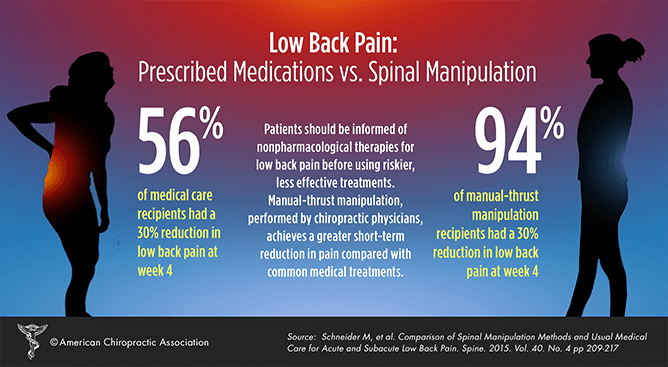
Low Back Pain: Prescribed Medications vs. Spinal Manipulation
Patients should be informed of nonpharmacological therapies for low back pain before using riskier, less effective treatments. Manual-thrust manipulation, performed by chiropractic physicians, achieves a greater short-term reduction in pain compared with common medical treatments.
56% of medical care recipients had a 30% reduction in low back pain at week 4.
94% of manual-thrust manipulation recipients had a 30% reduction in low back pain at week 4.
If you would like to no more about manual-thrust chiropractic back manipulation for low back pain, please contact Dr. Beecher at Beecher Chiropractic Clinic in Houston Texas!
Source: Schneider M. et al. Comparison of Spinal Manipulation Methods and Usual Medical Care for Acute and Subacute Low Back Pain, Spine 2015. Vol. 40. No. 4 pp 209-217.
Backpack Safety Checklist From Your Houston Chiropractor!
In 2013 alone, the U.S. Consumer Product Safety Commission cited 5,415 backpack-related injuries treated at emergency rooms. Doctors of chiropractic (DCs) point to the dangers of heavy backpacks, resulting in injuries ranging from acute and chronic back pain to other painful conditions.
The American Chiropractic Association (ACA) recommends that parents choose the right backpack (see list below) and then help their children pack them properly, leaving out unnecessary items to insure they weigh no more than 10 percent of a child’s body weight.
- Is the backpack the correct size for your child?
- Does the backpack have padded shoulder straps for comfort?
- Are the shoulder straps adjustable?
- Does your child use both straps?
- Does the backpack have a padded back?
- Does the backpack have compartments to keep contents in place?
Are you concerned for the back health of your child? Houston chiropractor – Dr. Beecher of Beecher Chiropractic Clinic can help you and your child!
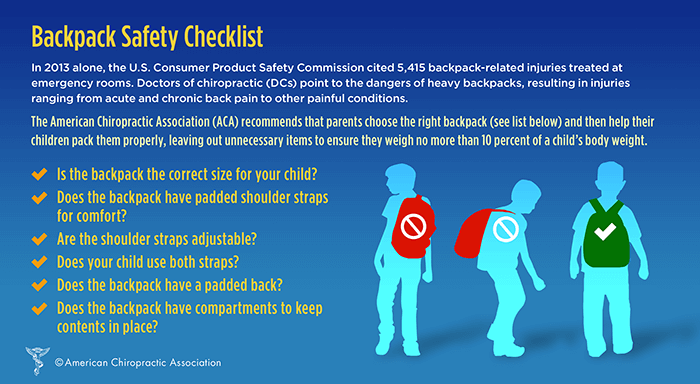
Why Is My Back Always Hurting?
Houston Area Chiropractor Comments: Low back pain is a very common problem affecting 80-90% of all of us at some point in our lifetime. Why is that you ask? There are many reasons. One of the biggest reasons is that we are 2-legged animals carrying 2/3rds of our weight above our waist. Studies have shown deterioration or arthritis occurs much sooner in us vs. our 4-legged animal counterparts. A 180 lbs man carries roughly 120 lbs above the waist. This means, every time he bends over, in order to stand upright, he needs to lift 120 lbs PLUS whatever he is lifting. Hence, the argument of, “…but I only bent over to lift a pencil and my back went out,” seems on the surface as impossible but in reality, the man in our example is lifting the pencil plus 120 lbs. Now, let’s add to that the point that a 5 pound weight equals 50 pounds when held out in front with the arms stretched out straight. Now, if that’s not bad enough, now, let’s assume all of this is happening from a bent forward position, with a twist at the waist, with out stretched arms, while lifting a 20 pound object. Get the idea? It’s amazing our back doesn’t get injured every day as we lift 2 bags of groceries into the far end of a car trunk, or, when lifting our 30 pound child in and out of a car seat, height chair, or when they are screaming and pushing away from us as we try to lift them!
In order to further appreciate why the low back is so vulnerable to injury, some basic understanding of anatomy is needed. When we’re born, the back is made up of 33 segments of which 5 fuse by the time we’re about 18 years old to make up the sacrum (bottom of the spine) and 4 fuse to make up the coccyx (tail bone), leaving 5 lumbar (low back), 12 thoracic (mid-back) and 7 cervical (neck) vertebra. These are stacked up on top of each other like building blocks and are connected to each other by a shock absorbing disk in the front and two smaller facet joints in the back, acting like a tripod. In the low back, we’re supposed to bear about 80% of our weight in the front and 20% in the back but, if our abdominal muscles are a bit out of shape and the pelvis rotates forwards, the curve in the low back increases and overloads the back of the vertebra (facets) making them vulnerable to injury. The disk becomes injured when we bend/lift/twist. This can tear the outer tough fibers of the disk, allowing the central more liquid-like material to leak out. If this happens, the leaking or “herniated” disk can put pressure on the nerve that exits the spine and travels down our leg. If the pain pattern includes the back of the leg, it’s commonly referred to as “sciatica.”
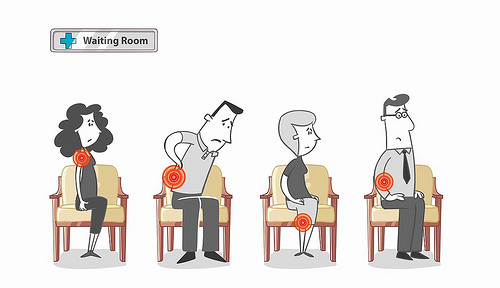
OK, enough about anatomy. What can we do to reduce the chances of having periodic low back pain? Obviously, staying in shape is very important. Certain muscles of the body must be tight to keep us upright or standing. These muscles need to be stretched on a regular basis. For example: the hamstring muscle. We’ve all had to perform hurdler types of exercises and remember how tight they feel!
We realize that you have a choice in where you choose for your healthcare services. If you, a friend or family member requires care for low back pain, we sincerely appreciate the trust and confidence shown by choosing our services and look forward in serving you and your family presently and, in the future.
Dr. Ward Beecher practices at your local Houston chiropractor – Beecher Chiropractic Clinic at 1001 Pineloch, Ste 700 Houston, TX 77062. You can schedule an appointment or call (281) 286-1300. If you have any questions regarding this blog, please comment below!
Chiropractic Care for Older Medicare Patients
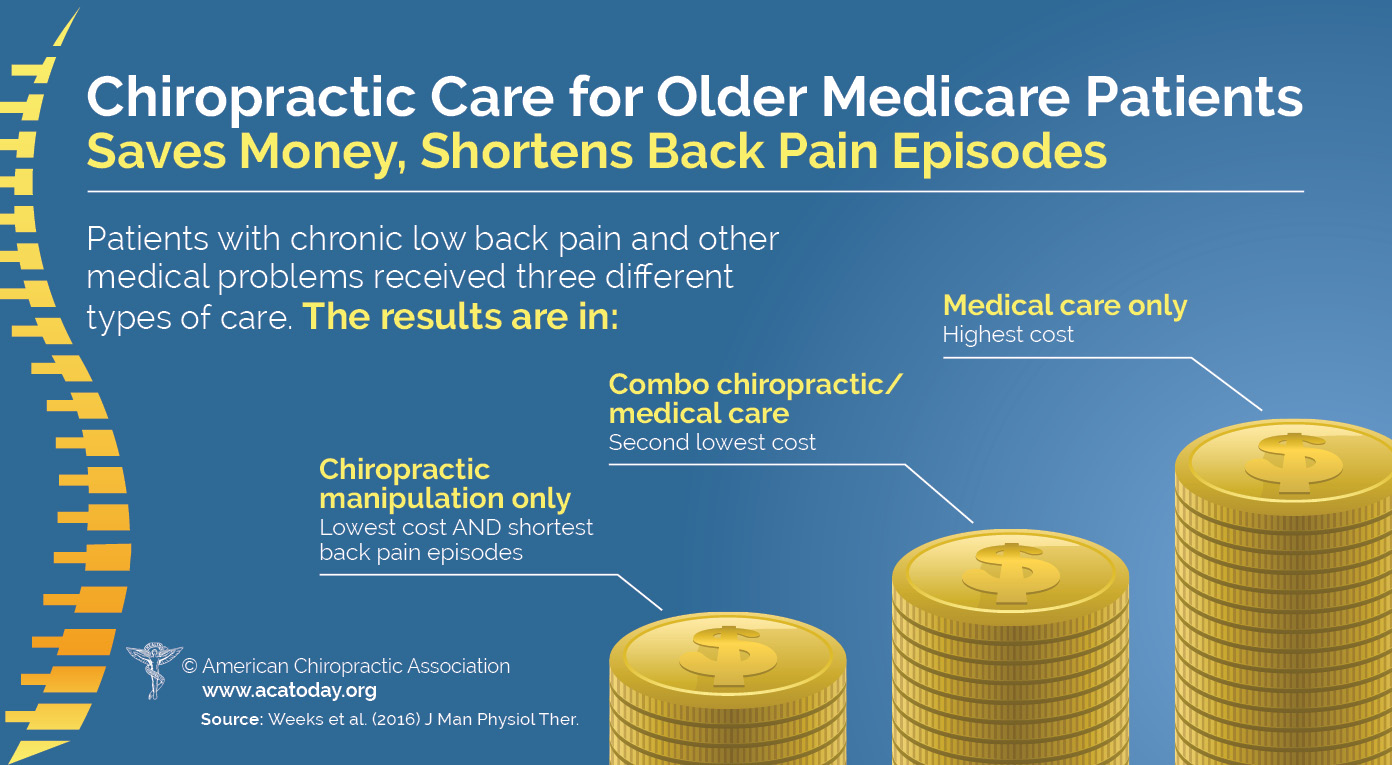
Saves Money, Shortens Back Pain Episodes
Patients with chronic low back pain and other medical problems received three different types of care. The results are in:
Chiropractic manipulation only: lowest cost and shortest back pain episodes
Combo chiropractic & medical care: second lowest cost
Medical care only: highest cost
If you want to lower your healthcare costs and also shorten your pain episodes, call your local Houston chiropractor now! We can help shorten your experience with back pain in Houston and neck pain.
Chiropractic and Opioid Prescriptions
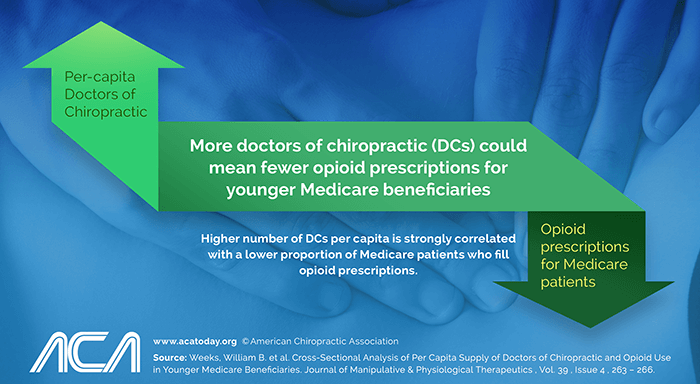
More doctors of chiropractic (DCs) could mean fewer opioid prescriptions for younger Medicare beneficiaries.
Higher number of DCs per capita is strongly correlated with a lower proportion of Medicare patients who fill opioid prescriptions. If you currently have back pain, neck pain, or need a chiropractic care in Houston, please consult with your local Houston chiropractor – Dr. Beecher. Natural solutions can be had like chiropractic for opioid prescriptions.
Low Back Pain & Spinal Manipulation – American College of Physicians
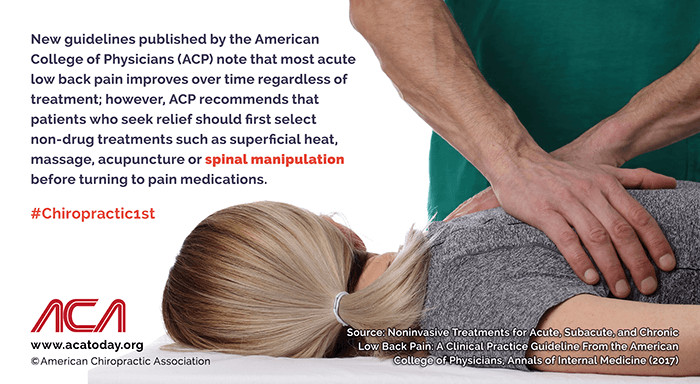
New guidelines published by the American College of Physicians (ACP) note that most acute low back pain improves over time regardless of treatment; however, ACP recommends that patients who seek relief should first select non-drug treatments such as superficial heat, massage, acupuncture or spinal manipulation before turning to pain medications.
Chiropractic Care For Elderly Lower Back Pain
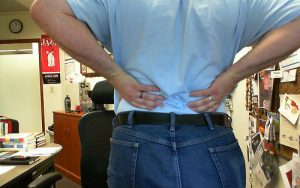
Clear Lake Chiropractor Comments: Chiropractic treatment of elderly lower back pain (LBP) has been reported to be very safe and highly effective. In fact, back in 1994, guidelines were published recommending that chiropractic treatment of low back pain should be a first consideration / treatment of choice in front of many other forms of back care health services. Since that time, more and more studies have been published showing continued advantages of chiropractic care over many other forms of LBP care.
Even though studies have shown that the peak prevalence of LBP occurs in the 5th decade of life, LBP is also a significant public health problem in older adults ranging between 13% and 49% with “…soaring costs in terms of health care expenditures.” So, what about care for the elderly – is chiropractic care equally safe and effective in this older population as it is in younger patients?
A recent study reported two types of spinal manipulation or adjustments verses minimal conservative medical care (MCMC) in patients with subacute or chronic, non-radiating elderly lower back pain over 55 years of age. This included a total of 240 participants, of which 105 were women and 135 were men with an average age of 63 years. The two types of manipulation included a high velocity low amplitude type (the classic “cracking” type of manipulation) and a low velocity variable amplitude type (stretch – not associated with a “crack”) treated 12 times over a 6 week time frame. A 3rd treatment group (MCMC) served as a “control” to compare against the two manipulation approaches. All three groups received a half hour exercise session at week 3 and outcomes were studied at 3, 6, 12 & 24 weeks. The results showed equally effective benefits to the two styles of manipulation over the MCMC group, with no serious adverse events associated with any of the treatment groups.
This study is important in a number of ways. First, it points out that two distinctive styles of manipulation frequently utilized in chiropractic and likely to be encountered by patients obtaining chiropractic care, are equally effective in a population exceeding 55 years of age for elderly lower back pain. The type of manipulation ultimately decided upon can therefore be based on: 1) patient preference (as some patients just don’t like being “cracked”) and 2) the chiropractor’s clinical experience.
When visiting our clinic, we take pride in providing accurate, up-to-date information about our patient’s condition and what must be done to obtain long term, satisfying results. We are most appreciative to have the opportunity to provide care to our patients and strive to make the experience highly satisfying.
If you, a family member or a friend requires care, we sincerely appreciate the trust and confidence shown by choosing our services. We are proud that chiropractic care for elderly lower back pain has consistently scored the highest level of satisfaction when compared to other forms of health care provision and look forward in serving you and your family presently and, in the future.
Dr. Ward Beecher practices at Beecher Chiropractic Clinic at 1001 Pineloch, Ste 700 Houston, TX 77062. You can schedule an appointment at BeecherChiropractic.com or by calling (281) 286-1300. If you have any questions regarding this blog, please comment below!
What Do Insurance Companies Say About Chiropractic?
Houston Chiropractic Comments: If chiropractic care helps patients get better faster and costs the patient and/or insurance company less, shouldn’t EVERY low back pain patient FIRST see a chiropractor before any other type of doctor? That is in fact, what should be done, based on the literature.

A few years ago a report was delivered on the impact on population, health and total health care spending. It was found the addition of chiropractic care for the treatment of neck and low back pain “…will likely increase value-for-dollar in US employer-sponsored health benefit plans.” Authored by an MD and an MD/PhD, and commissioned by the Foundation for Chiropractic Progress, the findings are clear; chiropractic care achieves higher satisfaction and superior outcomes for both neck and low back pain in a manner more cost effective than other commonly utilized approaches.
The study reviews the fact that low back and neck pain are extremely common conditions consuming large amounts of health care dollars. In 2002, 26% of surveyed US adults reported having back pain in the prior 3 months, 14% had neck pain and the lifetime prevalence of back pain was estimated at 85%. LBP accounts for 2% of all physician office visits where only routine examinations, hypertension, and diabetes result in more. Annual national spending is estimated at $85 billion in the US with an inflation-adjusted increase of 65% compared to 1997. The numbers have continued to rise thru 2016 as the population ages. Treatment options are diverse ranging from rest to surgery, including many various types of medications. Chiropractic care, including spinal manipulation and mobilization, is reportedly also widely utilized with almost half of all patients with persisting back pain seeking chiropractic treatment.
In review of the scientific literature, it is noted that 1) chiropractic care is at least as effective as other widely used therapies for low back pain; 2) Chiropractic care, when combined with other modalities such as exercise, appears to be more effective than other treatments for patients with neck pain. Other studies reviewed reported patients who had chiropractic coverage included in their insurance benefits found lower costs, reduced imaging studies, less hospitalizations, and surgical procedures compared to those with no chiropractic coverage. They then utilized a method to compare medical physician care, chiropractic physician care, physiotherapy led exercise and, manipulation plus physiotherapy-led exercise for low back pain care. They found adding chiropractic physician care is associated with better outcomes.
When combined with exercise, chiropractic physician care was also found to be very cost-effective when compared to exercise alone. When comparing the cost effectiveness of chiropractic care with or without exercise even at 5 times the cost of the care they utilized in their analysis, it was still found to be “substantially more cost-effective” compared to the other approaches. It will be interesting given these findings if insurance companies and future treatment guidelines start to MANDATE the use of chiropractic FIRST – it would be in everyone’s best interest!
If you, a family member or a friend require care, we sincerely appreciate the trust and confidence shown by choosing our services and look forward in serving you and your family presently and, in the future.
Dr. Ward Beecher practices at Beecher Chiropractic Clinic at 1001 Pineloch, Ste 700 Houston, TX 77062. You can schedule an appointment at BeecherChiropractic.com or by calling (281) 286-1300. If you have any questions regarding this blog, please comment below!

